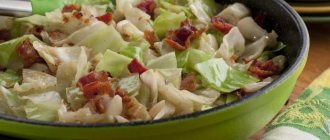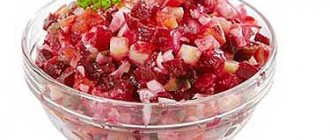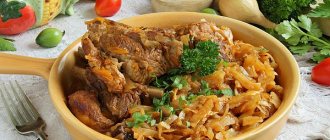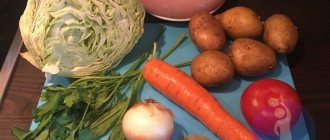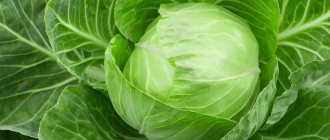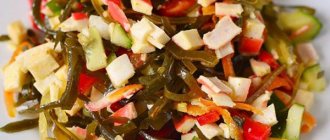Calorie content of the dish and benefits for the body
It’s worth answering the burning question right away, which concerns the energy component of sauerkraut.
So, the calorie content is 19 kcal per 100 grams of product. This is a so-called “negative calorie” product.
In other words, it takes much more calories to digest a given dish than the body will receive from the dish.
Figs turn out to be a very interesting product. Find out about the beneficial properties of figs and contraindications for consumption. Do you know which foods contain fast carbohydrates? You will find the answer at the link. Recommended for athletes to take before training.
As for the beneficial properties, there are much more of them than in fresh vegetables. And the secret is hidden in lactic acid bacteria. They are released during fermentation.
In addition to the fact that these bacteria are very beneficial for the body, they also act as a natural preservative, which effectively “preserves” all the vitamins, nutrients and trace elements in the vegetable.
So, just one spoon fulfills the body’s daily requirement for vitamin K.
And he, by the way, is responsible for normal blood clotting.
Cabbage is rich in B vitamins and vitamin C.
The former are responsible for the nervous system, the latter for the immune system.
Very often people like to cook dumplings from sauerkraut. Their calorie content is 174 kcal per 100 g of product.
The benefits and harms of sauerkraut
The beneficial properties of sauerkraut are difficult to overestimate. First of all, it is a storehouse of vitamin C, which supports the immune system. In addition, the popular vegetable is famous for its content:
- vitamin K, necessary to improve blood quality and heart function;
- B vitamins that support the health of the nervous system;
- microelements that have a beneficial effect on the tone of the body.
But still, do not forget that cabbage fermentation is caused by fermentation processes, which can negatively affect the functioning of the gastrointestinal tract, causing severe bloating. People with diabetes should also use cabbage in this form with caution.
Cooking delicious cabbage soup
An original Russian dish - cabbage soup made from sauerkraut.
Some people simply call it sauerkraut soup.
This dish is consumed by many of our compatriots not only for its excellent taste, but also for its low calorie content.
So, without frying, the calorie content of sauerkraut cabbage soup with potatoes will be 37 kcal per 100 grams of product.
This is even less if you try a dish with butter.
They also like to make solyanka with this cabbage, the calorie content of which is 134 kcal per 100 grams of product.
Sauerkraut with butter and onions
Number of servings: 8
Preparation time: 20 minutes
Cooking time: 1 hour
Energy value of the product
- kcal – 90.8;
- proteins – 1.5 g;
- fats – 8.3 g;
- carbohydrates – 8.7 g.
Ingredients
- white cabbage – 1 head;
- onion – 1 pc.;
- sugar – 1 tbsp;
- vegetable oil – 1 tbsp;
- table vinegar – 200 ml;
- water – 500 ml;
- salt - to taste.
Step-by-step preparation
- The cabbage should be washed and finely chopped, and the onion should be peeled and cut into thin rings.
- In a saucepan you need to cook cabbage with onions and sprinkle with vegetable oil.
- Pour water into another pan, bring it to a boil and add sugar, salt, vegetable oil and vinegar. The marinade should be sour.
- Pour boiling water over the cabbage and onions and cover the pan with them with a lid.
- After the water reduces the temperature, you need to carefully drain it and transfer the cabbage and onions to a container, which is then stored in the refrigerator. Properly cooked cabbage according to the classic recipe has a sour taste.
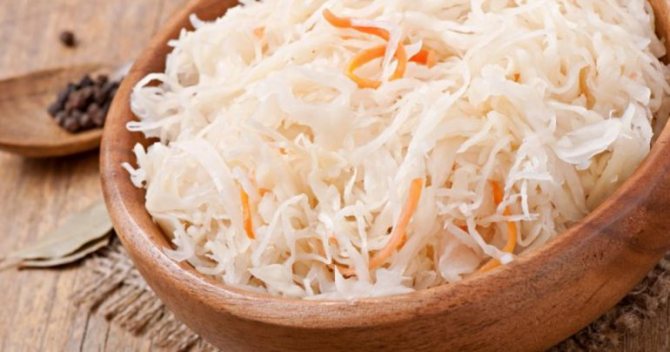
The healing effects of sauerkraut
Such a simple product as sauerkraut can have a healing effect on the body. But only if it is a high-quality product prepared according to all the rules.
- Sauerkraut is used as a preventive and therapeutic agent for erectile dysfunction. Systematic use of the product strengthens male sexual power and prevents early impotence.
- When used regularly, the product acts as a preventative against lung, intestinal and breast cancer, and helps fight cancer in the early stages.
- Eating cabbage reduces symptoms of headaches or joint pain.
- The condition of the oral mucosa improves, which accelerates the healing process of small cracks and ulcers, and freshens breath.
Delicious recipe!
TV show for today Novosibirsk Russia Cabbage brine helps in the treatment of liver diseases and reduces hangover symptoms. For pregnant women, brine helps fight toxicosis. The juice cleanses the intestines of toxins and poisons and improves digestion.
Sauerkraut is a product that causes a lot of controversy among women losing weight. Some beauties believe that it is better not to eat such a product, as it will slow down the process of weight loss. Others, on the contrary, are inclined to believe that you need to eat only cabbage, then the hated kilograms will “run away”.
In fact, you shouldn’t eat only pickled vegetables, since such a menu will be unbalanced and therefore harm the body. But it’s quite possible to add a product that many people love to your diet; you’ll see for yourself when you find out the calorie content of sauerkraut.
Finding out the energy value of pickled vegetables
Let's start right away with the question of the calorie content of sauerkraut per 100 grams. So, the indicated amount of product contains only 19 kcal. Nutritionists call this vegetable a product with negative calorie content.
This is due to the fact that the body spends more energy on digesting white sauerkraut than it receives. Of course, few people eat pickled vegetables in their “pure” form; it is usually used to create a filling for dumplings, prepare cabbage soup and salads.
The simplest appetizer, sauerkraut with vegetable oil, has a considerable calorie content. 100 grams of the finished dish contains at least 60 kcal if you add only 1 tsp to the dish. butter Therefore, if you are on a diet, it is better not to experiment with dressings, but to add fresh carrots to the dish.
Dumplings with sauerkraut: finding out the calorie content and learning how to cook
Not all housewives use fermented product as a filling for dumplings and, by the way, this is in vain. By adding cabbage to your dish, you can get a very tasty dish that will not harm your figure.
Not everyone knows, but cabbage is simply a storehouse of nutrients, especially sauerkraut, it has a beneficial effect on the skin, strengthens the immune system, improves intestinal function and contains a whole “bouquet” of vitamins.
If you want to have a slim figure and at the same time eat deliciously, learn how to cook dumplings with vegetable filling.
To create a test you need:
- fresh chicken egg – 1 pc.;
- hot water – 1 glass;
- wheat flour – 5 tbsp. l. (4 for dough and 1 spoon for rolling out the workpiece);
- bran – 1 tbsp. l. (possible with a slide);
- salt – 1 tsp.
For the filling take:
- sauerkraut – 500 grams;
- 1 large onion;
- 2 tbsp. l. with vegetable oil.
Let's talk about the sequence of preparing dumplings.
- First of all, you need to knead the dough, to do this, pour hot water into a convenient bowl, add flour to it, leaving 1 spoon for rolling out the dough, egg, salt, bran;
- Mix all the ingredients thoroughly, you should get a dough that does not stick to the handles. Once you achieve the desired effect, place the dough on a cutting board and cover with a large plate, leave the dough for 30 minutes;
- Now is the time to move on to preparing the filling. Place the cabbage in a colander and rinse under running water. Allow excess liquid to drain and lightly squeeze the vegetable. After all the manipulations, scroll the cabbage through a meat grinder;
- Remove the skins from the onion and chop as finely as possible;
- Fry the prepared onion in a frying pan with the addition of vegetable oil until light golden brown;
- Place cabbage in a frying pan and simmer over low heat, covered, until excess liquid has evaporated. Don't forget to stir the dish;
- The dough is ready, the filling is ready too, you can start making dumplings. To do this, roll out the workpiece into a thin layer, having previously sprinkled the table with flour, and, armed with a faceted glass, cut out circles from it;
- Place the filling on the prepared flatbread using a convenient teaspoon. Then pinch the loose edges of the dough;
- Make other dumplings in the same way;
- When everything is ready, place your little masterpieces in boiling salted water for about 7 minutes. Then fish them out and serve them. For those who do not watch their figure, the dish can be flavored with sour cream. Natural yogurt is suitable for those losing weight.
Delicious recipe! Salad with Margelan radish and carrots
The calorie content of cooked dumplings will be 120 kcal per 100 grams; if you want to reduce this figure, do not fry the onions in vegetable oil, but simmer them in water.
Cabbage soup from sauerkraut: finding out the calorie content, learning to cook
The first dish with the addition of cabbage is an original Russian dish that probably any housewife can cook. Moreover, each lady has her own “secret” recipe for preparing a delicious first meal. Well, we’ll look at the option of creating cabbage soup that even ladies on a diet can eat, and we’ll also look at where you can “cut” the calorie content of the dish.
To prepare cabbage soup you will need:
- meat with bone, take pork - 0.5 kg;
- fresh potatoes – 6 tubers;
- sauerkraut – 600 g;
- carrots – 1 pc.;
- onion – 1 head;
- garlic – 2 cloves;
- parsley and green onions 30 g each;
- tomato paste – 1 tbsp. l.;
- vegetable oil – 50 g;
- clean water – 3.5 l;
- salt and pepper to taste;
- bay leaf – 2 pcs.;
- sour cream with a fat content of no more than 10 - 150 g.
Stages of preparing cabbage soup.
- Rinse the pork under running water, remove excess fat, place in a saucepan and cover with water;
- Place the container with meat on the gas and, when the water boils, remove the resulting foam, then turn the heat to minimum and cook the pork for at least 60 minutes;
- Chop the cabbage, if necessary, and immerse in the broth, cook for an hour;
- When the pork is cooked, remove it from the pan, cool slightly, separate it from the bones, chop it randomly and put it back into future cabbage soup;
- Wash the potatoes, remove the peelings and add to the broth without cutting;
- When the tubers are ready, remove them from the pan, puree them and return them to the broth;
- Pour vegetable oil into a frying pan and fry peeled and grated carrots, finely chopped onions and garlic, add tomato paste;
- When the vegetables are cooked, place them in a saucepan, add spices to taste, and throw in the bay leaves. Cook everything together for 7 minutes, then remove the bay leaf and turn off the gas;
- Serve cabbage soup in portioned bowls, garnished with finely chopped parsley and green onions. Season with sour cream.
100 grams of the former will contain about 50 kcal. Of course, an adult will not be full with such a small portion, and accordingly, the energy value of the meal will increase. If you think that the caloric content is high, then you can easily reduce them, for example, by cooking cabbage soup broth not with pork, but with beef or chicken breast. You can also remove the potatoes from the first one.
Stewed sauerkraut: finding out the calorie content, learning to cook
For many nations, stewed cabbage is considered a national dish, and different countries have their own interesting cooking recipes. They may vary slightly, but that makes them no less tasty. We will consider the simplest preparation option so that you can enjoy the dietary product.
To create a dish you need:
- cabbage – 1 kg;
- fresh onion - 1 head;
- vegetable oil – 1 tbsp. l.;
- tomato paste – 1 tbsp. l.;
- salt and pepper to taste;
- sugar – 1 small spoon;
- bay leaf – 2 pcs.;
- clean water – 200 ml.
Let's talk about the stages of preparing stewed cabbage.
- Pour vegetable oil into a frying pan and fry the peeled and chopped onion in half rings until transparent;
- Add cabbage to the vegetable and simmer for 5-7 minutes, then add bay leaf and favorite spices to the pan;
- Pour water into the dish where everything is being prepared, cover the dish with a lid and simmer over low heat for about 30 minutes. It is important to ensure that the liquid does not evaporate completely, otherwise the food will burn. If there is not enough water, add hot water as needed;
- After half an hour, add tomato paste to the pan and simmer the dish for another 30 minutes;
- The last step is to add sugar, pepper everything, stir, let the food stand for 5 minutes and you can serve.
The energy value of the dish is about 40 kcal per 100 grams.
Cabbage is a product that can be eaten during weight loss. The main thing is to choose the right dishes and not make a calorie “bomb” out of a dietary product. Eat tasty and varied food, good luck!
The materials posted on this page are informational in nature and intended for educational purposes. Site visitors should not use them as medical advice. Determining the diagnosis and choosing a treatment method remains the exclusive prerogative of your attending physician.
Delicious recipe! Pizza in silicone mold in the oven
Sauerkraut is one of the simplest and healthiest products, known since ancient times and is still a favorite not only in ordinary, but also in festive feasts. Sauerkraut is loved and cooked not only in Russia; it is considered the national dish of Germany, Belarus, the Czech Republic, Poland and other countries (calorizator). Sauerkraut is a chemical process of lactofermentation that occurs as a result of fermentation of lactic acid bacteria in cabbage and sugars in cabbage juice released during ripening. Housewives and huge food industry enterprises ferment cabbage; sauerkraut differs in the type of cutting, it can be shredded, chopped, whole cabbage (and sourdough is also found in halves, quarters and segments of a head of cabbage).
Calorie content of sauerkraut
The calorie content of sauerkraut is 19 kcal per 100 grams of product.
Composition and beneficial properties of sauerkraut
The uniqueness of sauerkraut is that the amount of vitamins and minerals it contains is several times greater than the fresh white cabbage from which it is prepared. The main vitamin present in sauerkraut is vitamin C, a known antioxidant. The product also contains vitamins of group B (B1, B2, B5, B6, B9), K, U and PP, macro- and microelements include potassium, calcium, zinc, selenium, iron, iodine, phosphorus and sodium. Thanks to the cooking method, in which the product is not heated, all vitamins are completely preserved and do not lose their properties for 8-10 months after the sauerkraut “ripens”. Fiber and dietary fiber contained in sauerkraut help normalize digestive processes and gently cleanse the body; cabbage is useful for diseases of the cardiovascular and nervous system, is a recognized immunostimulant and remedy for vitamin deficiency, strengthens the walls of blood vessels and lowers blood sugar levels. Sauerkraut and especially its juice (brine) is a well-known remedy for hangovers and nausea, and often helps expectant mothers cope with the manifestations of toxicosis. Lactic acid, formed during the fermentation process, not only manifests itself in the specific smell of the product (similar to the smell of soaked apples), but is a preservative that protects against the appearance of pathogenic bacteria.
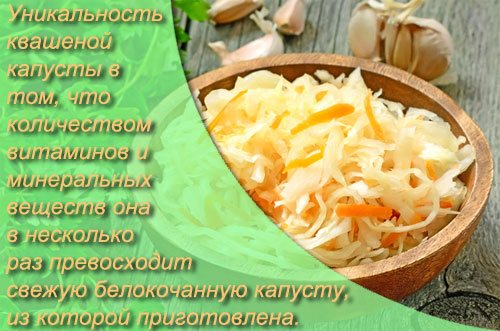
Harm of sauerkraut
It is not recommended to use sauerkraut for people with stomach and duodenal ulcers, gastritis with high acidity, or high blood pressure. With the so-called “weak” intestines, the product can cause flatulence and bloating.
Preparation and storage of sauerkraut
In order to prepare sauerkraut, you need a minimum of money and time - cabbage, salt and, if desired, carrots. The cabbage is peeled, chopped using the chosen method (finely chopped, chopped or cut into large pieces), mixed with carrots and salt, and lightly crushed by hand to quickly form juice. The cabbage is placed tightly in an enamel or glass container, and the lucky owners of oak tubs or barrels place it in them, compact it, cover it with a lid or an inverted plate and press it down with pressure on top. Depending on the temperature, the cabbage should stand for 2 to 8 days, then it is pierced with a long knitting needle to allow gases to escape and transferred to a cool, or better yet, a cold place. You can store cabbage in the same container where it was prepared, in the cellar or on the balcony; if this is not possible, it is preferable to transfer the cabbage into glass jars, close tightly and store in the refrigerator. The best time to prepare sauerkraut is autumn, when white, flat heads of cabbage ripen. Additives to cabbage include cranberries, lingonberries, black peppercorns, and bay leaves.
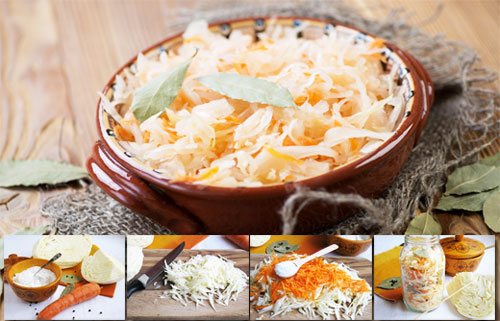
Sauerkraut for weight loss
Having a record low calorie content and a large number of beneficial properties, sauerkraut is often used as a snack or side dish in many diets and fasting days. Simply using sauerkraut as a vitamin supplement to meat dishes several times a week will “lighten” your weight by several kilograms without strict dietary restrictions.
